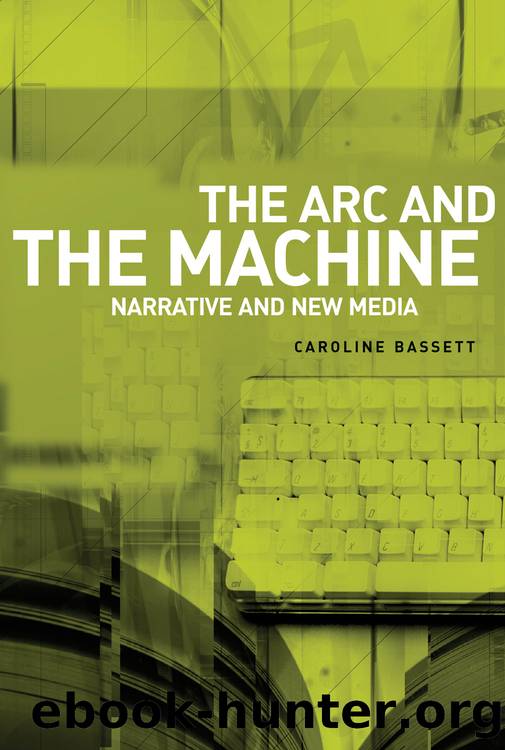The Arc and the Machine: Narrative and the New Media by Caroline Bassett

Author:Caroline Bassett [Bassett, Caroline]
Language: eng
Format: epub
Tags: Social Science, Literary Criticism, Popular Culture, Anthropology, Cultural & Social, Semiotics & Theory
ISBN: 9780719073427
Google: S2S5DwAAQBAJ
Goodreads: 5987821
Publisher: Manchester University Press
Published: 1966-01-01T00:00:00+00:00
Those with whom the archive dwells: narrative, memory, identity
In the popular register, identity is often discussed in narrative terms. Life stories define who we are, and condition what we may become. Obituaries are obvious examples of this way of thinking about a life but so are ongoing soap-opera stories of celebrity purveyed in popular magazines, or the biographies of public figures, groups, or whole populations, whether these last are produced to account, to explain, to condemn, to forgive, or perhaps in restitution for an injustice done. Identity theft, as it is adumbrated in the press, by definition relating to personality as well as to plastic (a part of oneself is stolen as well as a credit card), is also viewed as the theft of a life story.
These formulations have theoretical resonances, of course. Later in this chapter I consider accounts of narrative identity developed by Hannah Arendt, Adriana Cavarero and Paul Ricoeur. All three have elaborated accounts of the connections and relations between various actors, spaces and texts that might constitute an extended narrational economy. All share a conviction that âthe lifeâ exceeds âthe textâ, although in different ways in each account. In fact it is the relationship between the life story and the life, and the degree to which both are included in a broader narrative arc, that constitutes the problematic of narrative identity in each of their accounts. For various reasons cyber-cultural theorists have not generally explored narrative identities but have tended to consider digital subjects as textually or cyber-textually produced, and/or as discursively performed (see Stone, 1995; Turkle, 1995; Farquhar, 2000, for instance). This theorization of the subject within cyber-theory, stressing âlife on the screenâ (Turkle, 1995), led to a focus on immersion to the neglect of interactivity, with its focus on processes of connection between different places, spaces and forms of embodied use.
I have already argued that interaction can be usefully be explored through narrative. Bringing identity into the mix develops these possibilities. If narrative identity is automated in particular ways within digital systems, then how might life stories be archived, edited and reassembled in forms influenced and constrained by the architecture of the system, by users who may in the end narrate or refuse the tale? My hope is that addressing identity from this perspective might open the way to different forms of thinking about how digital identity can be understood. In particular, it might offer new ways in which the surveillant subject, on the one hand, and the theoretically weightless and âfreeâ cyber-subject, who is now so often regarded as entirely âenchainedâ, on the other, can be reconceptualized beyond these dichotomies. It is feasible and productive to explore the role of technological mediations in the production of an identity (or a life story), beginning with an account of social existence that is, as Kottman put it, not predicated on interpellation (Kottman, 2000) but that might be said rather to subsume and exceed it. Thus a turn to narrative might begin to suggest new forms of political response to forms of identity emerging within informational culture.
Download
This site does not store any files on its server. We only index and link to content provided by other sites. Please contact the content providers to delete copyright contents if any and email us, we'll remove relevant links or contents immediately.
The Power of Myth by Joseph Campbell & Bill Moyers(1001)
Half Moon Bay by Jonathan Kellerman & Jesse Kellerman(952)
A Social History of the Media by Peter Burke & Peter Burke(935)
Inseparable by Emma Donoghue(921)
The Nets of Modernism: Henry James, Virginia Woolf, James Joyce, and Sigmund Freud by Maud Ellmann(833)
The Spike by Mark Humphries;(764)
The Complete Correspondence 1928-1940 by Theodor W. Adorno & Walter Benjamin(746)
A Theory of Narrative Drawing by Simon Grennan(742)
Culture by Terry Eagleton(712)
Ideology by Eagleton Terry;(696)
Bodies from the Library 3 by Tony Medawar(680)
Farnsworth's Classical English Rhetoric by Ward Farnsworth(673)
World Philology by(673)
Game of Thrones and Philosophy by William Irwin(669)
High Albania by M. Edith Durham(654)
Adam Smith by Jonathan Conlin(648)
A Reader’s Companion to J. D. Salinger’s The Catcher in the Rye by Peter Beidler(646)
Comic Genius: Portraits of Funny People by(616)
Monkey King by Wu Cheng'en(609)
